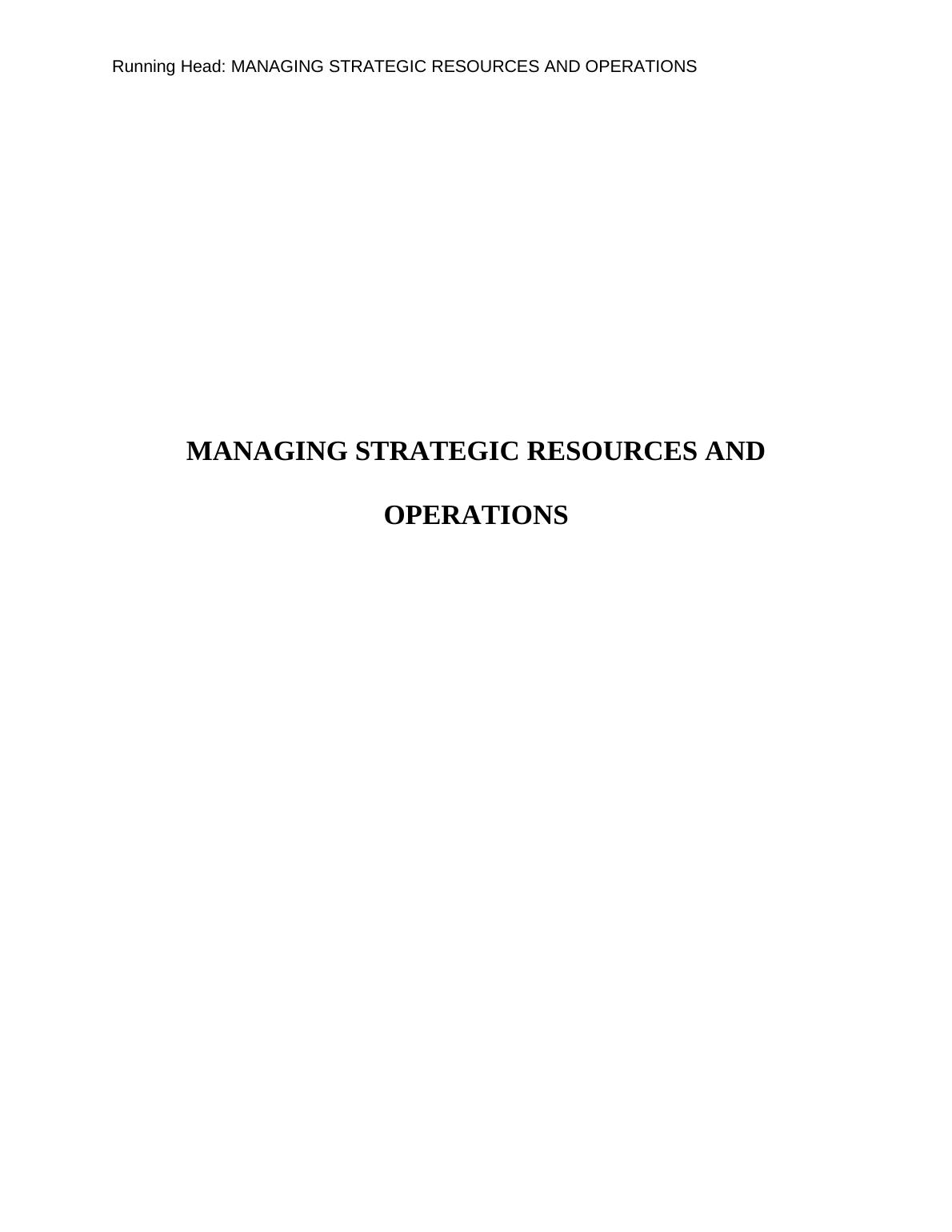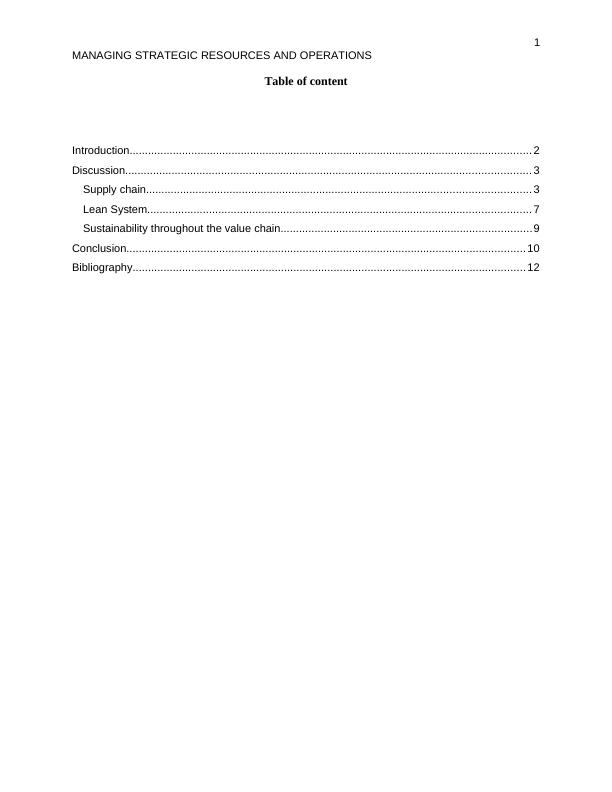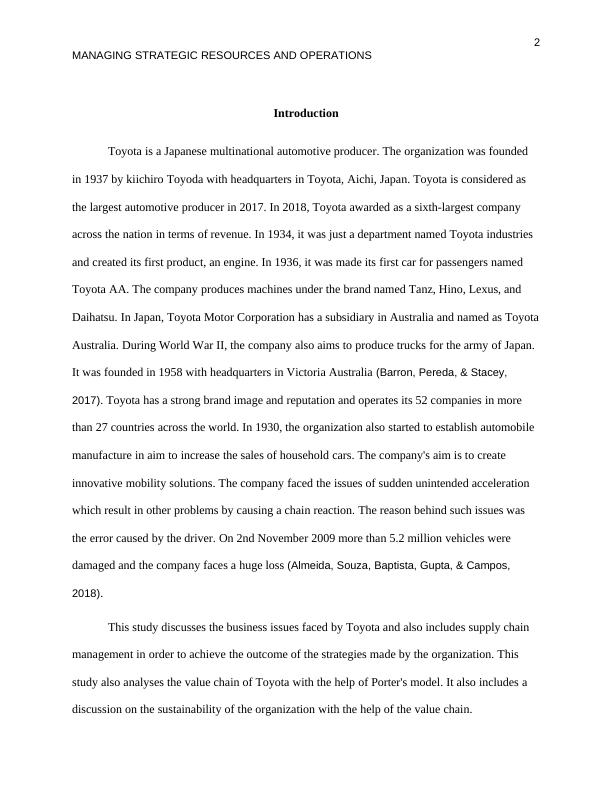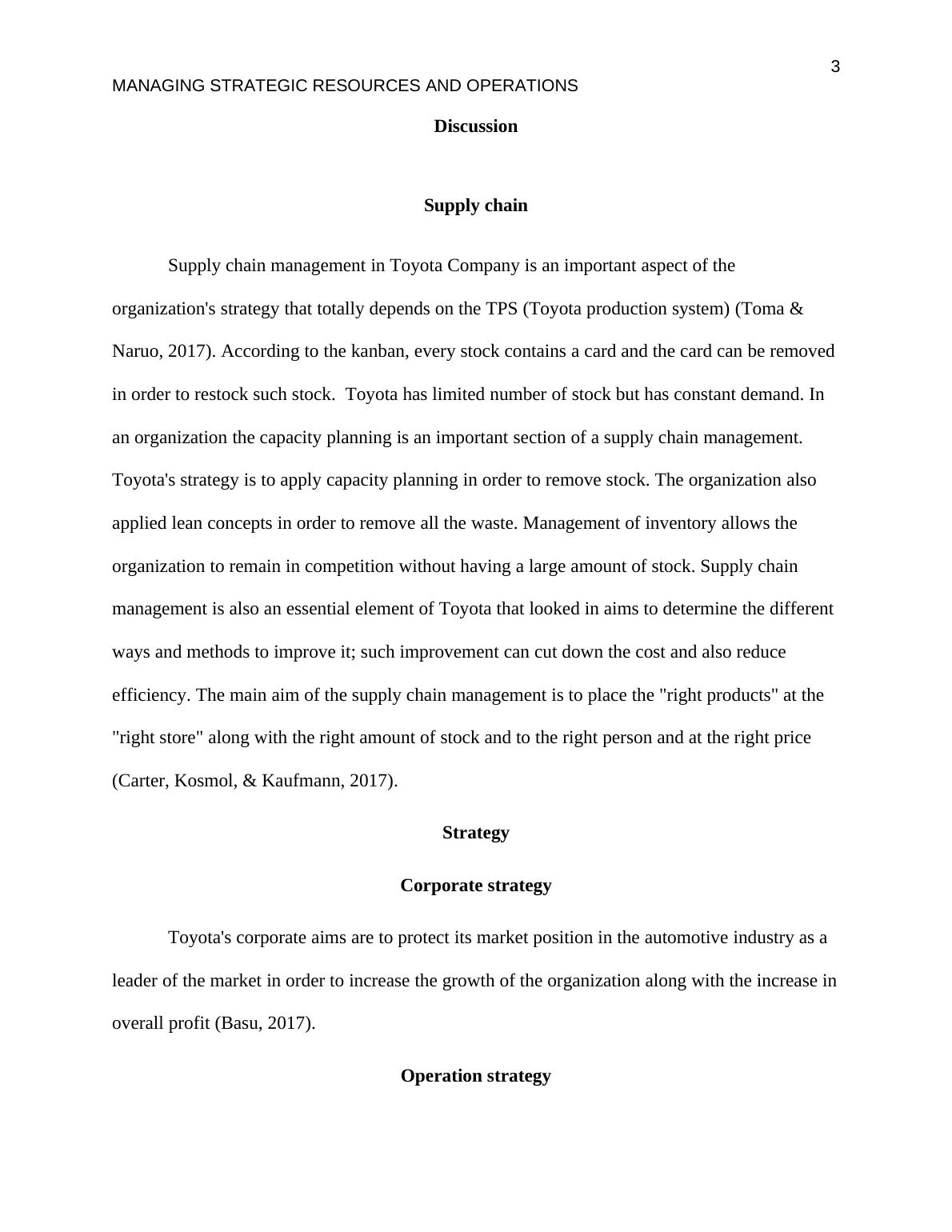Managing Strategies | Assessment 1
Added on 2022-10-04
15 Pages3696 Words13 Views
Running Head: MANAGING STRATEGIC RESOURCES AND OPERATIONS
MANAGING STRATEGIC RESOURCES AND
OPERATIONS
MANAGING STRATEGIC RESOURCES AND
OPERATIONS

1
MANAGING STRATEGIC RESOURCES AND OPERATIONS
Table of content
Introduction.................................................................................................................................. 2
Discussion................................................................................................................................... 3
Supply chain............................................................................................................................ 3
Lean System............................................................................................................................ 7
Sustainability throughout the value chain.................................................................................9
Conclusion................................................................................................................................. 10
Bibliography............................................................................................................................... 12
MANAGING STRATEGIC RESOURCES AND OPERATIONS
Table of content
Introduction.................................................................................................................................. 2
Discussion................................................................................................................................... 3
Supply chain............................................................................................................................ 3
Lean System............................................................................................................................ 7
Sustainability throughout the value chain.................................................................................9
Conclusion................................................................................................................................. 10
Bibliography............................................................................................................................... 12

2
MANAGING STRATEGIC RESOURCES AND OPERATIONS
Introduction
Toyota is a Japanese multinational automotive producer. The organization was founded
in 1937 by kiichiro Toyoda with headquarters in Toyota, Aichi, Japan. Toyota is considered as
the largest automotive producer in 2017. In 2018, Toyota awarded as a sixth-largest company
across the nation in terms of revenue. In 1934, it was just a department named Toyota industries
and created its first product, an engine. In 1936, it was made its first car for passengers named
Toyota AA. The company produces machines under the brand named Tanz, Hino, Lexus, and
Daihatsu. In Japan, Toyota Motor Corporation has a subsidiary in Australia and named as Toyota
Australia. During World War II, the company also aims to produce trucks for the army of Japan.
It was founded in 1958 with headquarters in Victoria Australia (Barron, Pereda, & Stacey,
2017). Toyota has a strong brand image and reputation and operates its 52 companies in more
than 27 countries across the world. In 1930, the organization also started to establish automobile
manufacture in aim to increase the sales of household cars. The company's aim is to create
innovative mobility solutions. The company faced the issues of sudden unintended acceleration
which result in other problems by causing a chain reaction. The reason behind such issues was
the error caused by the driver. On 2nd November 2009 more than 5.2 million vehicles were
damaged and the company faces a huge loss (Almeida, Souza, Baptista, Gupta, & Campos,
2018).
This study discusses the business issues faced by Toyota and also includes supply chain
management in order to achieve the outcome of the strategies made by the organization. This
study also analyses the value chain of Toyota with the help of Porter's model. It also includes a
discussion on the sustainability of the organization with the help of the value chain.
MANAGING STRATEGIC RESOURCES AND OPERATIONS
Introduction
Toyota is a Japanese multinational automotive producer. The organization was founded
in 1937 by kiichiro Toyoda with headquarters in Toyota, Aichi, Japan. Toyota is considered as
the largest automotive producer in 2017. In 2018, Toyota awarded as a sixth-largest company
across the nation in terms of revenue. In 1934, it was just a department named Toyota industries
and created its first product, an engine. In 1936, it was made its first car for passengers named
Toyota AA. The company produces machines under the brand named Tanz, Hino, Lexus, and
Daihatsu. In Japan, Toyota Motor Corporation has a subsidiary in Australia and named as Toyota
Australia. During World War II, the company also aims to produce trucks for the army of Japan.
It was founded in 1958 with headquarters in Victoria Australia (Barron, Pereda, & Stacey,
2017). Toyota has a strong brand image and reputation and operates its 52 companies in more
than 27 countries across the world. In 1930, the organization also started to establish automobile
manufacture in aim to increase the sales of household cars. The company's aim is to create
innovative mobility solutions. The company faced the issues of sudden unintended acceleration
which result in other problems by causing a chain reaction. The reason behind such issues was
the error caused by the driver. On 2nd November 2009 more than 5.2 million vehicles were
damaged and the company faces a huge loss (Almeida, Souza, Baptista, Gupta, & Campos,
2018).
This study discusses the business issues faced by Toyota and also includes supply chain
management in order to achieve the outcome of the strategies made by the organization. This
study also analyses the value chain of Toyota with the help of Porter's model. It also includes a
discussion on the sustainability of the organization with the help of the value chain.

3
MANAGING STRATEGIC RESOURCES AND OPERATIONS
Discussion
Supply chain
Supply chain management in Toyota Company is an important aspect of the
organization's strategy that totally depends on the TPS (Toyota production system) (Toma &
Naruo, 2017). According to the kanban, every stock contains a card and the card can be removed
in order to restock such stock. Toyota has limited number of stock but has constant demand. In
an organization the capacity planning is an important section of a supply chain management.
Toyota's strategy is to apply capacity planning in order to remove stock. The organization also
applied lean concepts in order to remove all the waste. Management of inventory allows the
organization to remain in competition without having a large amount of stock. Supply chain
management is also an essential element of Toyota that looked in aims to determine the different
ways and methods to improve it; such improvement can cut down the cost and also reduce
efficiency. The main aim of the supply chain management is to place the "right products" at the
"right store" along with the right amount of stock and to the right person and at the right price
(Carter, Kosmol, & Kaufmann, 2017).
Strategy
Corporate strategy
Toyota's corporate aims are to protect its market position in the automotive industry as a
leader of the market in order to increase the growth of the organization along with the increase in
overall profit (Basu, 2017).
Operation strategy
MANAGING STRATEGIC RESOURCES AND OPERATIONS
Discussion
Supply chain
Supply chain management in Toyota Company is an important aspect of the
organization's strategy that totally depends on the TPS (Toyota production system) (Toma &
Naruo, 2017). According to the kanban, every stock contains a card and the card can be removed
in order to restock such stock. Toyota has limited number of stock but has constant demand. In
an organization the capacity planning is an important section of a supply chain management.
Toyota's strategy is to apply capacity planning in order to remove stock. The organization also
applied lean concepts in order to remove all the waste. Management of inventory allows the
organization to remain in competition without having a large amount of stock. Supply chain
management is also an essential element of Toyota that looked in aims to determine the different
ways and methods to improve it; such improvement can cut down the cost and also reduce
efficiency. The main aim of the supply chain management is to place the "right products" at the
"right store" along with the right amount of stock and to the right person and at the right price
(Carter, Kosmol, & Kaufmann, 2017).
Strategy
Corporate strategy
Toyota's corporate aims are to protect its market position in the automotive industry as a
leader of the market in order to increase the growth of the organization along with the increase in
overall profit (Basu, 2017).
Operation strategy

End of preview
Want to access all the pages? Upload your documents or become a member.
Related Documents
Strategic Management Report on Toyota PDFlg...
|6
|2168
|23
Logistics & Supply Chain Management of Toyota Motor Corporationlg...
|14
|3650
|106
Logistics and Supply Chain Management of Toyota Motor Corporationlg...
|10
|2748
|170
Nature of Enterprise Systems for Operational Efficiency and Innovationlg...
|11
|3429
|81
Strategic Supply Chain on Material Handling: Automotive Industry in Japan Specifically on Toyota Company.lg...
|4
|889
|11
Role of IT in Toyota's Supply Chainlg...
|20
|4289
|343
